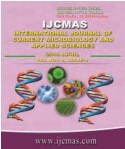


 National Academy of Agricultural Sciences (NAAS)
National Academy of Agricultural Sciences (NAAS)

|
PRINT ISSN : 2319-7692
Online ISSN : 2319-7706 Issues : 12 per year Publisher : Excellent Publishers Email : editorijcmas@gmail.com / submit@ijcmas.com Editor-in-chief: Dr.M.Prakash Index Copernicus ICV 2018: 95.39 NAAS RATING 2020: 5.38 |
In order to investigate the relationships among the drought tolerance/resistance indices an experiment was conducted in alpha lattice design with two replications under two moisture regimes during the crop season 2015-16. Thirteen indices, which were most frequently used in plant breeding, were compared based on grain yield of 20 durum wheat genotypes. Highly significant differences for yield (Yp and Ys) and all drought tolerance indices except TOL were observed which indicated that genotypes were differing for genes controlling yield and drought tolerance indices. The mean of grain yield under non stress condition (Yp) values ranged between 4.60(BIJAGA RED) to 20.53 (g/plant) (MP 1279), whereas under stress condition (Ys) yield range was found between 2.32(N 59) to 8.67 g/plant (MP 1279). It is remarkable that the genotypes MP 1279 and DWR 185 and CG 1010 had high performances in both stressed and non-stressed conditions for grain yield. The grain yield reduction was ranged between 12.58 to 76.18 per cent in drought plots. The average reduction in grain yield due to drought stress was 58 per cent. This explains the massive reduction in yield under severe drought stress for majority of genotypes. Therefore, moderate drought stress environments are more preferable as compared to severe drought stress to identify drought tolerant lines. STI-related indices (K1STI and K2STI) were found convenient parameters to select high-yielding genotypes in both stress and non-stress conditions. The MP, GMP and YI indices, which were highly positively and significantly correlated to the grain yields in both favorable and drought stress environments, were introduced as the best indices. Significant and positive correlation of Yp and Ys (r=0.68 p<0.05) was found which indicates that high yield performance under favorable condition resulted in relatively high yield under stress conditions. Both Yp and Ys were significantly and positively correlated (P<0.05) with, MP (r=0.96 and 0.84), GMP (r=0.96 and 0. 83), HM (r=0.83 and 0.97), YI (r=0.68 and 1.00), K1STI (r=0.72 and 0.63) and K2-STI (r=0.73 and 0.98). This indicates that these indices were more effective in identifying high yielding lines under drought stress as well as non-stress conditions
 |
 |
 |
 |
 |